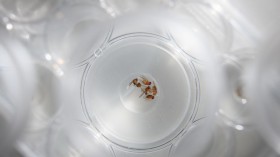Mealworms may be able to help keep Styrofoam of out landfills, according to researchers from Stanford University. Not only do the worms happily feed on the non-biodegradable plastic, but they also convert it into carbon dioxide and nutrient-rich waste for plants to use.
Americans annually throw away 2.5 billion plastic foam cups. However, this only accounts for a small fraction of the total 33 million tons of plastic discarded each year, which leads to water contamination and animal poisoning, noted the Stanford study.
"Our findings have opened a new door to solve the global plastic pollution problem," Wei-Min Wu, co-author and a senior research engineer in the Department of Civil and Environmental Engineering at Stanford, said in a news release.
Mealworms, which are at the larvae stage of darkling beetles, ate between 34 and 39 milligrams of Styrofoam per day, according to the researchers. This is equivalent to the weight of a small pill. The tiny worms then converted half of the plastic into carbon dioxide and excreted the remaining waste within 24 hours.
"Mealworms fed a steady diet of Styrofoam were as healthy as those eating a normal diet," Wu added, "and their waste appeared to be safe to use as soil for crops."
Craig Criddle, a professor of civil and environmental engineering who led the researchers during their plastic study, noted that sometimes science is surprising and there is always the possibility that important research will come from the most bizarre of places.
Their findings, recently published in the journal Environmental Science and Technology, have significant implications for the management of pollution.
For more great nature science stories and general news, please visit our sister site, Headlines and Global News (HNGN).
-Follow Samantha on Twitter @Sam_Ashley13
© 2024 NatureWorldNews.com All rights reserved. Do not reproduce without permission.





